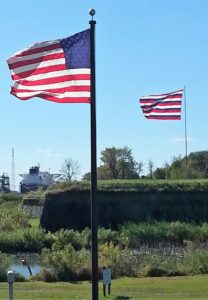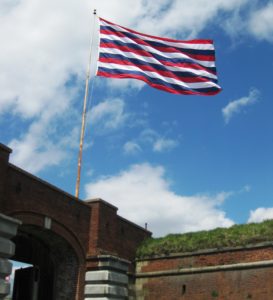#MakeItBetterMonday – Flags and Symbols
What will YOUR flag mean?
 A symbol is something that represents or stands for something else – often an idea or abstract concept. The American flag is an easily recognized symbol of patriotism, its meaning extending beyond the 13 stripes for 13 colonies and 50 stars for 50 states. The federal courts determined that the American flag is “the symbol of our national unity, transcending all internal differences however large, within the framework of our Constitution.” This symbol of our national life goes to battle with soldiers, flies at sporting events, over post offices, schools and the White House. It honors fallen heroes inspires bravery and pride.
A symbol is something that represents or stands for something else – often an idea or abstract concept. The American flag is an easily recognized symbol of patriotism, its meaning extending beyond the 13 stripes for 13 colonies and 50 stars for 50 states. The federal courts determined that the American flag is “the symbol of our national unity, transcending all internal differences however large, within the framework of our Constitution.” This symbol of our national life goes to battle with soldiers, flies at sporting events, over post offices, schools and the White House. It honors fallen heroes inspires bravery and pride.
Francis Scott Key penned the Star Spangled Banner after being inspired by seeing the flag waving over Fort McHenry following intense British bombardment during the War of 1812. Years before, in 1777, the Fort Mifflin flag remained flying throughout the British throughout the siege and bombardment here.
Flag Day commemorates the official adoption of the flag of the United States by the Second Continental Congress on June 14, 1777. President Woodrow Wilson issued a proclamation honoring the anniversary of the flag resolution in 1916, and congress officially designated June 14 as National Flag Day in 1949.
The Fort Mifflin Flag
 The distinctive Fort Mifflin flag was also an official flag of the Continental Navy. Lacking the familiar blue union field of stars, it consists of alternating stripes of red, white and blue representing the thirteen states of the new nation. The flag typically flown at the Fort is a large garrison flag, about half the size of the flag at Fort McHenry flag of the War of 1812 (the “Star Spangled Banner”) and could be seen 7 miles away in Philadelphia.
The distinctive Fort Mifflin flag was also an official flag of the Continental Navy. Lacking the familiar blue union field of stars, it consists of alternating stripes of red, white and blue representing the thirteen states of the new nation. The flag typically flown at the Fort is a large garrison flag, about half the size of the flag at Fort McHenry flag of the War of 1812 (the “Star Spangled Banner”) and could be seen 7 miles away in Philadelphia.
During the siege and bombardment of Fort Mifflin (October 6 – November 15, 1777) the flag was kept flying despite the British bombardment, the greatest of the American Revolution. Although at one point British cannonballs were falling into the fort at the rate of 1,000 an hour, General Washington ordered the American garrison to “hold to the last extremity.” Two brothers from Pennsylvania, Sergeant Andrew Mackemson and Lieutenant James Mackemson, were both killed in re-raising the shot torn flag. The fort was finally evacuated by the last defenders early in the morning of November 16th, but was never surrendered to the British. The Fort Mifflin flag was still flying to the end.
Design your own flag! Click HERE to get some ideas and a special reward if you bring your flag to Fort Mifflin.
Want to learn more?
Learn how to respectfully handle the American Flag
Stay Connected